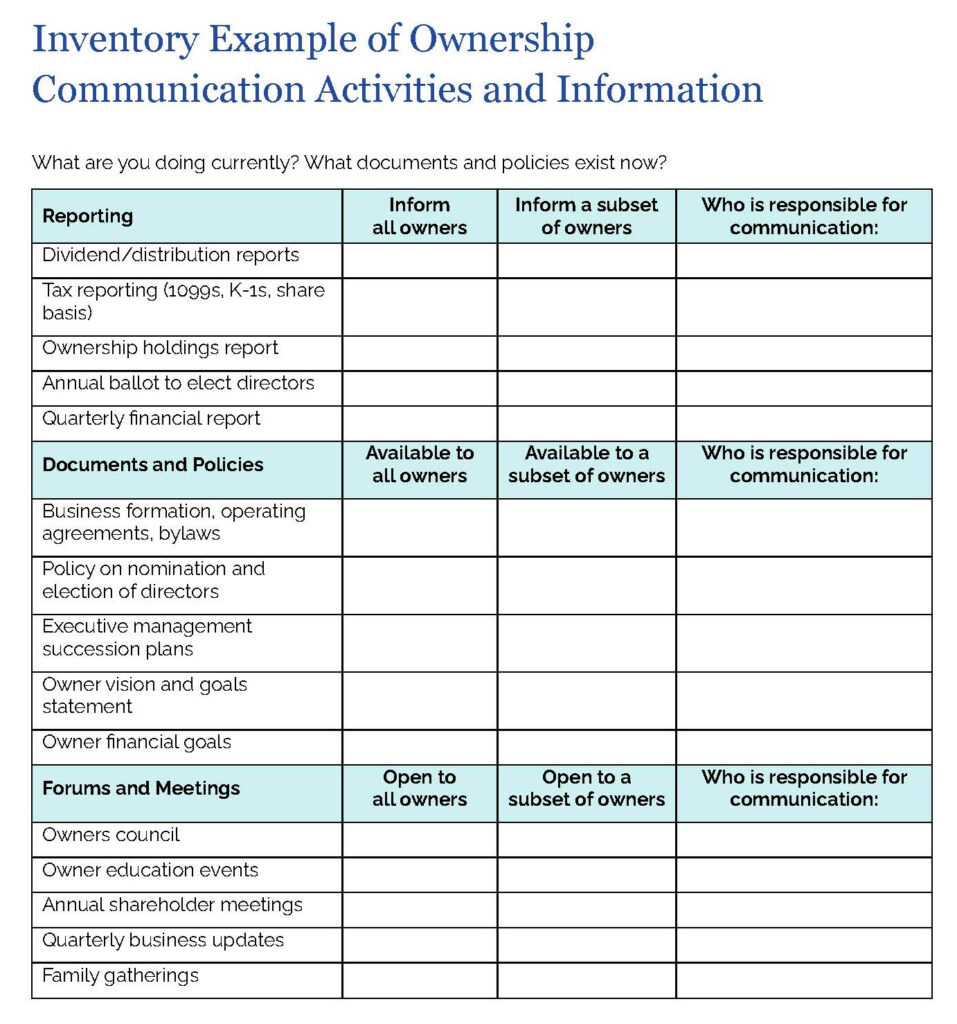As family ownership persists through generations, it’s common for the owner group to evolve to include members who do not work in the business. Many of our client families experience this change not as a gradual shift over time, but as a sudden impact that disrupts established patterns of communication.
Decisions made by operating owners may no longer align with the priorities of the whole owner group, such as choices to reinvest in business growth rather than distributing cash to owners. Family members who “own by chance, not by choice” begin to wonder why they are holding onto an illiquid investment that they know little about. It’s often at this inflection point that my colleagues and I get the call with questions like: “How can we connect with our owners? What do they really want? What do they deserve?”
Bridge the Gap Between Operating and Non-Operating Owners
Family enterprises that sustain family ownership continuity across generations retain a key competitive advantage associated with patient capital: the ability to weather downturns and pursue counter-cyclical investments for growth. The financial returns from this approach are made possible by owners who understand their role. They work collectively to foster a mutually beneficial relationship between business and the family, committed to the continued flourishing of both.
It can be a challenge for operating owners to understand how their siblings, cousins, or offspring can be effective owners without being “on the inside” working for the family business. The operating owners have access to information along with significant responsibility. The non-operating owners in the business may feel uneasy about what they don’t know and may wonder if they are being treated fairly.
How do families successfully bridge the gap? With lots of curiosity about what it’s like to be in your cousin’s shoes, a learning mindset, and a clear intention to continue owning together. This approach helps your family owners build alignment where both operating owners and non-operating owners are in a relationship and working together with a shared purpose.
What All Family Owners Deserve
In their gem of a book, Family Business Ownership: How to be an Effective Shareholder, Aronoff, McClure and Ward note what all family owners deserve:
- Leadership
- Emotional and financial returns
- Protection for the business
- Information
- Accountability
- Respect
Reflect on the current, tangible actions you take to connect your owners with one another and the business. Then, examine existing communication practices within the enterprise and assess how well they serve all owners’ needs for information, accountability, and respect. Equitable access to information helps all owners feel “in the loop” and less anxious about what they don’t know. Management and the board demonstrate accountability with a consistent reporting cadence that builds owners’ confidence in the information shared and quells the spread of misinformation. Respect is shown in owner meetings, with time reserved for leaders to listen to the ideas and concerns of all owners, including those who hold non-voting interests or who are beneficial owners through trusts.
Start by Taking Inventory
Lead owners are encouraged to inventory how and what they are currently communicating with and for owners. Don’t worry about what you don’t have; instead, focus on your existing strengths. Learn which activities and resources are valued by owners, as these can form the foundation for building a framework for ongoing owner engagement.
A confidential survey is an effective and efficient way to gather feedback from your owners. Be sure to communicate why you are seeking this input, how the information will be used, and thank the owners for making time to complete it. The act of requesting this feedback is a sign of respect and attentiveness to your owner group. (The exercise of sending out an online survey also generates updated owner contact preferences and information, a nice dividend!) Compile and share the results, note recurring topics, and gain insights into what is working for your owners and where there are opportunities for growth.
Clarify Roles and Give Support to Those Responsible for Ownership Communication Activities
Upon review, you may find that responsibility for communicating with owners is distributed among employees of the business and family volunteers. Whether it is the long-time employee in the accounting department who prepares family tax returns or the dedicated cousin who organizes the annual family retreat, roles and boundaries are often unclear for these individuals, sub-optimizing their effectiveness and thwarting accountability. Sometimes operating owners are seen as more than equal and receive special attention and “better service.”
Identify employees who handle owner-facing activities and assess the situation:
- Is their role clear to themselves and to your owner group?
- Do they have the resources and authority needed to fulfill their responsibilities?
- Are they aware of privacy and confidentiality concerns?
- Is there a long-standing and trusted business leader designated to support them in resolving conflicts with family owners?
Employees play a valuable part in engaging and developing your owner group, and this work should be integrated into their performance review and professional development planning.
Family volunteers who have assumed a role in owner communication can be highly valuable. They may have built close relationships with many owners and are seen as trustworthy. Note which family members have taken on this work and reflect:
- Is their role clear to themselves and to your owner group?
- How are they receiving and understanding the information they are sharing?
- Are they guided by your owners’ collective vision and values?
- Are they handling topics that are better addressed by management or the board?
- Are they aware of privacy and confidentiality concerns?
Some families use an owners’ council structure to organize owner involvement and development activities. (See definition below.)
Transform Learning into Action
Creating a cohesive and engaged ownership group is an ongoing process that ideally becomes an aspirational value for family members across generations. We encourage you to take meaningful first steps toward becoming a learning organization[1] that engages all owners. Convene your group to share insights from the owner survey and what you discovered in the communication inventory. Facilitate discussions among owners to learn what they want to know and understand more fully, identifying topics that are important to most. Together, develop ideas on how to improve owner knowledge and understanding of a key topic, and form a responsible group to make it happen.
Encourage your owners to visualize the future, and think about welcoming the next generation of family owners by asking, “What ownership culture do we want for the next generation?” and “What needs to happen now to develop that culture?” As you work together on these matters of shared importance, owner relationships are strengthened.
Your investment in engaging your owners sets the foundation for family ownership continuity, building a culture that serves all owners’ needs for information, accountability, and respect. In turn, your family owners sustain their patient capital investment, positioning the business to thrive into the next generation of ownership.
What is an Owners’ Council?
An owners’ council is generally a stand-alone subset of the entire ownership group selected by the shareholders, or in some cases, a committee of the family council (selected by the shareholders) offering non-operating owners a venue to create value for the enterprise and interact on a level playing field with operating owners. Owners’ councils play a key role in:
- Establishing and articulating owners’ vision and goals
- Setting business targets for growth, risk, profitability, and liquidity
- Creating a forum for the CEO and other key leaders to connect with family owners
- Developing policies that affect both the family and business (e.g., a redemption policy or family employment policy)
- Facilitating owner collaboration and decision-making
One of the most valuable functions of an owners’ council is to foster relationships that encourage owners to address the inevitable challenges that arise with having operating owners and non-operating owners.
From The Family Council Handbook by Christopher J. Eckrich, Stephen L. McClure, pp 207 to 217
References and Resources
- [1] Peter Senge, The Fifth Discipline, Doubleday, 2006
- Downloadable Worksheet: Inventory Example of Ownership Communication Activities and Information
Books
- The Family Council Handbook: How to Create, Run, and Maintain a Successful Family Business Council
- Family Business Ownership: How to be an Effective Shareholder
- Own It! How to Develop a Family Enterprise Owner’s Mindset at Every Age
Articles
- Family Ownership Strategy: Generating Family Currency
- Family Owner Development — The Foundation for Continuity
- Investor Relations: Building Connections and Continuity for Family Enterprises
Webinar


